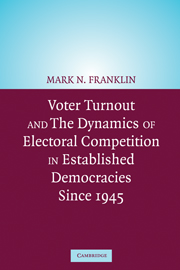39 results
Early voting experiences and habit formation
-
- Journal:
- Political Science Research and Methods / Volume 12 / Issue 1 / January 2024
- Published online by Cambridge University Press:
- 14 March 2023, pp. 195-206
-
- Article
- Export citation
The 2019 European Elections: something old, something new, something borrowed, and something green
-
- Journal:
- Italian Political Science Review / Rivista Italiana di Scienza Politica / Volume 50 / Issue 3 / November 2020
- Published online by Cambridge University Press:
- 14 December 2020, pp. 307-313
- Print publication:
- November 2020
-
- Article
-
- You have access
- Open access
- HTML
- Export citation
Contributors
-
-
- Book:
- How to Improve your ART Success Rates
- Published online:
- 05 July 2011
- Print publication:
- 30 June 2011, pp viii-xii
-
- Chapter
- Export citation
Contributors
-
-
- Book:
- The Cambridge Dictionary of Christianity
- Published online:
- 05 August 2012
- Print publication:
- 20 September 2010, pp xi-xliv
-
- Chapter
- Export citation
The Economic Vote: How Political and Economic Institutions Condition Election Results. By Raymond M. Duch and Randolph T. Stevenson. New York: Cambridge University Press, 2008. 416p. $45.00 cloth, $19.00 paper.
-
- Journal:
- Perspectives on Politics / Volume 7 / Issue 1 / March 2009
- Published online by Cambridge University Press:
- 12 February 2009, pp. 202-203
- Print publication:
- March 2009
-
- Article
- Export citation
Tables
-
- Book:
- Voter Turnout and the Dynamics of Electoral Competition in Established Democracies since 1945
- Published online:
- 08 February 2010
- Print publication:
- 19 April 2004, pp ix-x
-
- Chapter
- Export citation
Contents
-
- Book:
- Voter Turnout and the Dynamics of Electoral Competition in Established Democracies since 1945
- Published online:
- 08 February 2010
- Print publication:
- 19 April 2004, pp vii-vii
-
- Chapter
- Export citation
3 - The Role of Generational Replacement in Turnout Change
-
- Book:
- Voter Turnout and the Dynamics of Electoral Competition in Established Democracies since 1945
- Published online:
- 08 February 2010
- Print publication:
- 19 April 2004, pp 59-90
-
- Chapter
- Export citation
A - The Surveys Employed in This Book
-
- Book:
- Voter Turnout and the Dynamics of Electoral Competition in Established Democracies since 1945
- Published online:
- 08 February 2010
- Print publication:
- 19 April 2004, pp 225-230
-
- Chapter
- Export citation
2 - A New Approach to the Calculus of Voting
-
- Book:
- Voter Turnout and the Dynamics of Electoral Competition in Established Democracies since 1945
- Published online:
- 08 February 2010
- Print publication:
- 19 April 2004, pp 37-58
-
- Chapter
- Export citation
1 - Confronting the Puzzles of Voter Turnout
-
- Book:
- Voter Turnout and the Dynamics of Electoral Competition in Established Democracies since 1945
- Published online:
- 08 February 2010
- Print publication:
- 19 April 2004, pp 9-36
-
- Chapter
- Export citation
Author Index
-
- Book:
- Voter Turnout and the Dynamics of Electoral Competition in Established Democracies since 1945
- Published online:
- 08 February 2010
- Print publication:
- 19 April 2004, pp 263-266
-
- Chapter
- Export citation
7 - Understanding Turnout Decline
-
- Book:
- Voter Turnout and the Dynamics of Electoral Competition in Established Democracies since 1945
- Published online:
- 08 February 2010
- Print publication:
- 19 April 2004, pp 171-200
-
- Chapter
- Export citation
Bibliography
-
- Book:
- Voter Turnout and the Dynamics of Electoral Competition in Established Democracies since 1945
- Published online:
- 08 February 2010
- Print publication:
- 19 April 2004, pp 251-262
-
- Chapter
- Export citation
Introduction
-
- Book:
- Voter Turnout and the Dynamics of Electoral Competition in Established Democracies since 1945
- Published online:
- 08 February 2010
- Print publication:
- 19 April 2004, pp 1-8
-
- Chapter
- Export citation
5 - Explaining Turnout Change in Twenty-Two Countries
-
- Book:
- Voter Turnout and the Dynamics of Electoral Competition in Established Democracies since 1945
- Published online:
- 08 February 2010
- Print publication:
- 19 April 2004, pp 119-150
-
- Chapter
- Export citation
Frontmatter
-
- Book:
- Voter Turnout and the Dynamics of Electoral Competition in Established Democracies since 1945
- Published online:
- 08 February 2010
- Print publication:
- 19 April 2004, pp i-vi
-
- Chapter
- Export citation
Preface
-
-
- Book:
- Voter Turnout and the Dynamics of Electoral Competition in Established Democracies since 1945
- Published online:
- 08 February 2010
- Print publication:
- 19 April 2004, pp xi-xiv
-
- Chapter
- Export citation
B - Aggregate Data for Established Democracies, 1945–1999
-
- Book:
- Voter Turnout and the Dynamics of Electoral Competition in Established Democracies since 1945
- Published online:
- 08 February 2010
- Print publication:
- 19 April 2004, pp 231-236
-
- Chapter
- Export citation

Voter Turnout and the Dynamics of Electoral Competition in Established Democracies since 1945
-
- Published online:
- 08 February 2010
- Print publication:
- 19 April 2004



